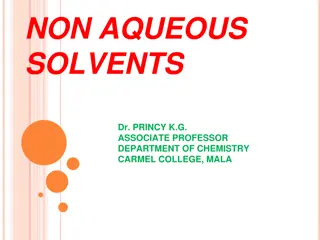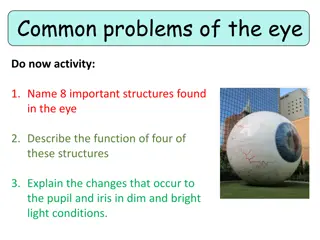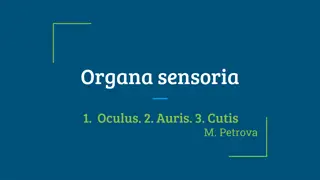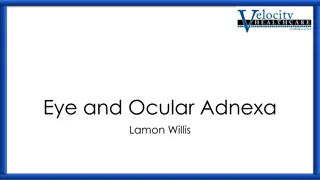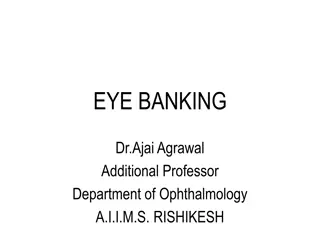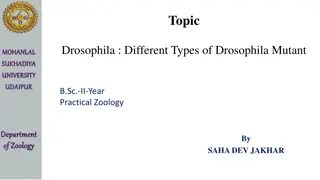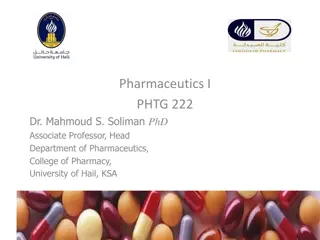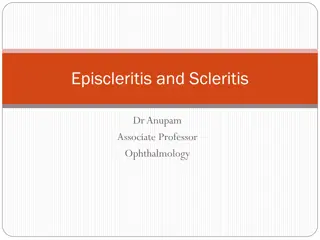Understanding the Role of Aqueous Humor in Eye Health
Aqueous humor is a vital fluid in the eye that maintains intraocular pressure, provides nutrition, and helps remove waste products. It also aids in transporting antioxidants like Vitamin C and plays a role in immune response. Composed mainly of water, ions, proteins, and nutrients, the aqueous humor flows through the eye, but imbalances can lead to conditions like glaucoma, affecting vision. Understanding its composition and function is crucial for eye health and disease prevention.
Download Presentation

Please find below an Image/Link to download the presentation.
The content on the website is provided AS IS for your information and personal use only. It may not be sold, licensed, or shared on other websites without obtaining consent from the author. Download presentation by click this link. If you encounter any issues during the download, it is possible that the publisher has removed the file from their server.
E N D
Presentation Transcript
The aqueous is the thin, watery fluid that fills the space between the cornea and the iris (anterior chamber). It is continually produced by the ciliary body, the part of the eye that lies just behind the iris. This fluid nourishes the cornea and the lens and gives the front of the eye its form and shape
Function Maintains the intraocular pressure . Provides nutrition (e.g. amino acids and glucose). Carries away waste products . May serve to transport ascorbate in the anterior segment to act as an anti-oxidant agent. * Presence of immunoglobulins indicate a role in immune response to defend against pathogens
* Vitamin C, being a water soluble antioxidant, protects body fluids such as saliva, blood, lymph, intra and intercellular fluids, and those fluids that surround the lens of the eye. A recent study headed by Dr. Allen Taylor of Tufts University found that women who had daily intakes of 362 mg or more of vitamin C had a 57 percent lower risk of developing cataracts by age 60 than women whose daily intakes were less than 140 mg. In older women and men, high intakes of vitamin C have been shown to delay the onset of cataract and reduce its severity
Composition The fluid is essentially the same as blood plasma although with less protein. Water: 99% Ions: HCO3-, buffers metabolic acids; Cl-, preserves electric neutrality; Na+; K+; Ca2+; PO43-. Proteins: albumin, -globulins. . Ascorbate: anti-oxidative, protects against UV. Glucose Lactate: produced by metabolism of anaerobic structures of the eye. Amino acids: transported by ciliary epithelial cells.
Flow of Aqueous Humor The fluid produced by the eye s ciliary body flows out freely. Aqueous humor flows from the ciliary body into the anterior chamber, out through a spongy tissue at the front of the eye called the trabecular meshwork and into a drainage canal
Disorders Glaucoma is a condition characterized by increased intraocular pressure (pressure within the eye) either through increased production or decreased outflow of aqueous humor. Uncontrolled glaucoma typically leads to visual field loss and ultimately blindness
The vitreous humor is the clear gel that fills the space between the lens and the retina of the eyeball of humans and other vertebrates. The vitreous is the transparent, colorless, gelatinous mass that fills the space between the lens of the eye and the retina lining the back of the eye It is produced by certain retinal cells.
It contains very few cells (mostly phagocytes which remove unwanted cellular debris, as well as the hyalocytes of Balazs, which produce the hyaluronic acid). No blood vessels, and 99% of its volume is water with salts, sugars, and a network of collagen with the muco-polysaccharide hyaluronic acid.
The collagen fibres of the vitreous are held apart by electrical charges. With ageing, these charges tend to reduce, and the fibres may clump together. Similarly, the gel may liquefy, a condition known as syneresis, allowing cells and other organic clusters to float freely within the vitreous humour. These allow floaters which are perceived in the visual field as spots or fibrous strands. Floaters are generally harmless, but the sudden onset of recurring floaters may signify a posterior vitreous detachment (PVD) or other diseases of the eye.
http://t3.gstatic.com/images?q=tbn:jof_bSY4NupgOM:http://www.eyesandeyesight.com/wp-content/floaters-in-the-eye.jpghttp://t3.gstatic.com/images?q=tbn:jof_bSY4NupgOM:http://www.eyesandeyesight.com/wp-content/floaters-in-the-eye.jpg


